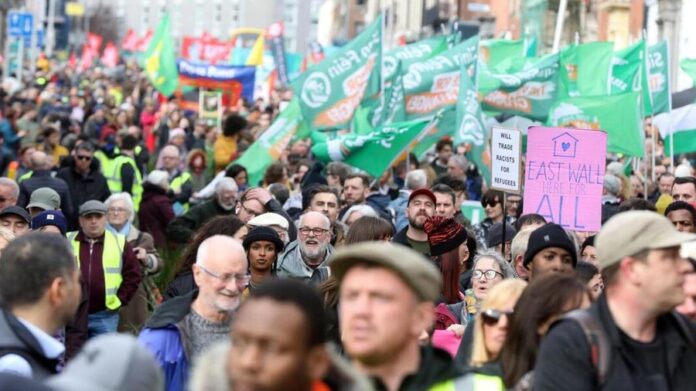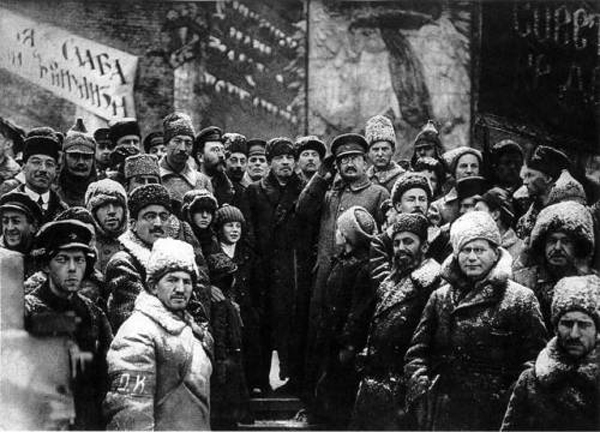Diarmuid Flood is a member of Ireland’s largest ecosocialist party People Before Profit and RISE – a revolutionary Marxist network which operates within it. He is a regular contributor to RISE’s publication Rupture and its podcast Rupture Radio.
Q: Information reached us that there were anti-immigrant protests in Ireland. Can you give us a picture of what is happening?
DF: Unfortunately in recent months we have seen an anti-refugee and anti-migrant movement developing in Ireland. This has taken the form of multiple protests outside centres housing men, women, and children.
These protests have taken place in working class communities across the country – in Dublin, Cork, Waterford, Limerick, Down, and Kilkenny. At their peak the numbers at these protests ranged from a few hundred to close to a thousand. Most strikingly they are often composed of the same people from working class communities who would have previously been on demonstrations driven by the socialist left for housing or the cost of living crisis. The amount of women and children at these protests is also notable.
Often playing a central role in these protests is the established network of far right groups who seek to harden the racist ideas present and spread misinformation. These groups, which experienced a boost in support during the Covid-19 pandemic, have had some success in targeting refugees and migrants and scapegoating them for the failures of the Irish government.
Q: What is the actual situation with the number of immigrants that are in Ireland at the moment?
DF: Late last year the Irish Government agreed to take in 70,000 Ukrainian refugees fleeing Russia’s invasion. This was on top of existing obligations to take refugees from Syria, Georgia, and elsewhere.
However, in line with their disastrous housing policies and the ongoing crisis, the government chose not to accommodate these refugees with housing but instead to shove them into ‘accommodation centres’ which were in reality repurposed office blocks and warehouses in working class communities. The far-right grasped onto this and made these centres the focus of attention and outrage.
Q: Can you give us some details about the propaganda of the far-right groups and how do you reply to it?
DF: As mentioned the Irish far-right have had some success in spreading misinformation about migrants and refugees in working class communities. This has been achieved through the circulation of fake videos and messages claiming that ‘violent’ ‘unvetted’ ‘military-aged’ males were being bussed into communities. They further made it seem that these refugees presented a threat to women and children and backed this up with fake stories and reports. Often real stories of crimes by Irish people are reframed to make it seem as if they were carried out by a migrant or refugee.
This propaganda offensive has had a real material effect. Vigilante groups have popped up in some areas and in February a homeless camp was destroyed by men with dogs and baseball bats. This attack was carried out with the justification that the homeless men were migrants when in reality most were students displaced by the housing crisis. There have also been instances of international students being racially abused and attacked by gangs of teens and a building was set on fire due to a fake rumour that it was going to be used to house refugees and migrants.
Q: How do these groups work? How do they use the internet and what presence do they have on the streets?
DF: The far-right in Ireland is composed of various heterogeneous groups ranging in character from outrightly fascist, to ultra-Catholic, anti-abortion, or anti-mask. While they initially presented a broad front when these protests first began, since then there has been a lot of infighting as the different groups jockey for prominence and control. It is normal now to see competing demonstrations organised by different groups.
There are two main players at the moment when it comes to the far-right. The first is a larger network of community groups which are amorphous and populist in character but tied to the ‘Irish Freedom Party’ led by a one-time advisor to Nigel Farage. The second is Ireland’s most prominent fascist organisation, The National Party, which is led by a Hitler-quoting graduate of Ireland’s ultra-Catholic youth circuit. All of the far-right groups send their activists into these protests to agitate and recruit.
These groups are engaged in the online propagandising I mentioned earlier and they have made use of Telegram and Facebook groups to draw in and hold the attention of people in these communities. Often community groups are taken control of or created with the intent of spreading far-right messaging.
Q: What was the response of the movement and the Left and what are RISE’s proposals to counter the rise of the far-right?
DF: Activists in People Before Profit, including those in the RISE network, have been working to build a united front against these protests in local communities and have been part of organising counter-demonstrations and solidarity rallies. Most recently on March 4th our Cork PBP branch participated in a successful counter demonstration which saw the far-right outnumbered 4:1.
As mentioned, a lot of work went into building the ‘Ireland For All’ demonstration on February 18th. This saw a turnout of nearly 30,000 people in Dublin and has had a real effect on demoralising the far-right who have struggled to maintain numbers at their protests since it took place.
Part of our work has also been to produce material which tackles the propaganda of the far-right for distribution online and in communities. This has included taking up the notion that these refugees present some threat or that they are the source of the issues in housing rather than the Irish government and the system they stand behind.
When it comes to strategy, we have advocated that the left take up a number of initiatives which were outlined by Paul Murphy in a Rupture article from January. It was stated this strategy should include:
- Major national mobilisations against the far-right and racist ideas. As well as a major national protest as soon as possible, we should try to bring together cultural and musical figures to participate in a ‘Rock Against Racism’ type event mobilising tens of thousands of people.
- Building community groups right across the country. These should involve progressive forces, but explicitly exclude government parties and criticise the government. Importantly, they should root themselves in working class communities, pre-empting protests of the far-right where possible and cutting across them.
- Working within the trade unions to win them to active participation in the fight against racist and far-right ideas. They should be seeking to mobilise their members against the attempts to divide working class people.
- Producing material which tackles the propaganda of the far-right for distribution online and in communities. While we should not imply that whole communities are racist, we should not hesitate in tackling the racist lies which are being spread.
- Confronting the far-right where they seek to openly organise. We cannot cede the streets to the far-right.
Largely this strategy has been implemented and as mentioned this has led to some success in pushing back the far-right and stemming the spread of their ideas. However, the struggle is far from over!













